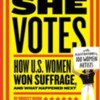It’s been 100 years since the ratification of the 19th Amendment secured voting rights for women—sort of. In She Votes: How U.S. Women Won Suffrage, and What Happened Next, author Bridget Quinn and 100 female artists survey the complex history of the struggle for women’s rights, including racial segregation and accommodation to White supremacy. They celebrate the hitherto under-recognized efforts by women of color to secure voting rights for all Americans, and BIPOC-led, diverse, and intersectional movements for equality.
In this excerpt, Quinn describes how White leaders of the women’s suffrage movement were influenced by Indigenous political structures and culture, and how some of this influence took place around Seneca Falls in upstate New York, site of the first U.S. convention for women’s rights.
It’s an under-known fact that the “revolutionary” concept of a democratic union of discrete states did not spring fully formed from the Enlightenment pens of the Founding Fathers, like sage Athena from the head of Zeus. No, the idea of “united states” sprang from the Haudenosaunee, collective name for six tribes that comprise the so-called (mostly by non-Natives) Iroquois Confederacy: the Seneca, Oneida, Mohawk, Onondaga, Cayuga, and Tuscarora nations. Should you doubt this, check out Congressional Resolution 331, adopted in 1988 by the 100th Congress of the United States, which says as much. It’s worth noting that the Haudenosaunee Confederacy still thrives today, likely the world’s oldest participatory democracy.
To read more of Bridget Quinn's article, please click here.



Comments (0)